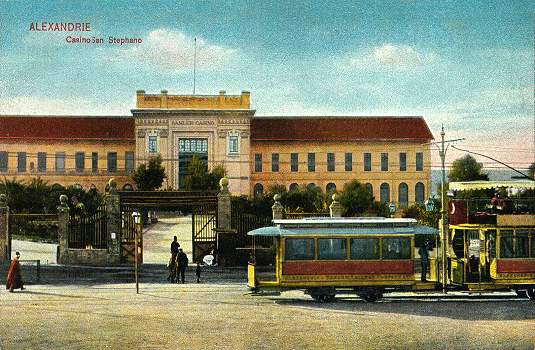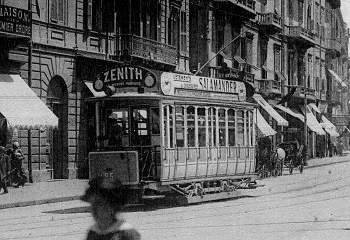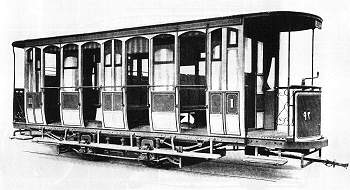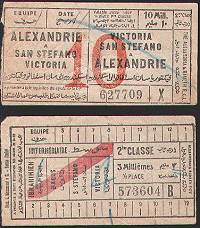

Alexandria is located on the Nile delta at the north of Egypt and originally had two tramways. Our main postcard shows trams on the Alexandria-Ramleh tramway outside the Ramleh Casino at San Stephano. It is card 50808 in a series published in about 1905 by S. N. Theodossiou of 7 Rue de la Poste, Alexandria.
The small second view (below) is in Ramleh Station Street in Alexandria and shows car 85 of the urban tramway. The picture is an extract from postcard number 17 in the Édition Artistique series from P. Coustoulides of Alexandria and dates from around 1914. The third view is an official photograph of this same type of tram in its open form.
See note on Egyptian Place Names.
The first line to Ramleh was a horse tramway opened in 1869 with a route from the city of Alexandria to San Stephano with a branch to Zinzinia, subsequently worked by steam tram locos with double-deck trailers. This line was bought by the British Engineering Company of Egypt in 1890, was nationalised in 1898 and, with a view to electrification, was leased back to the British company for a 30-year concession commencing in December 1902. As the Alexandria and Ramleh Electric Railway, public service began in December 1903. The line runs from Midan Zaghloul in Alexandria via Sidi Gaber Mosque and San Stephano to Victoria (now known as El Nasr) with variant routes via Sidi Gaber Station and Bacos.
The initial rolling stock for the Ramleh line was an order for 52 4-wheel standard gauge 4-window cars from the British Electric Car Company Ltd., of Trafford Park, England. Delivered in 1903 were 7 double-deck motor cars with canvas roofs, 10 double-deck open top trailers and 10 enclosed single-deck trailers (some of which were motor cars when first delivered and used as such until 1904), all on McGuire Columbian trucks. Our postcard shows one of these early trailer cars behind one of the 1903 double-deckers. In 1904, 25 identical double-deck motor cars with canvas roofs were delivered but these had Brill 21E trucks. The motor cars had controllers by Dick Kerr and motors by British Westinghouse. The double-deck cars seated 24 on the lower deck and 34 on the upper.
Between 1908 and 1914 large crossbench convertible cars on Brill 27G bogies were supplied by the United Electric Car Company of Preston (12 double-deck motor cars which seated 106, 13 single-deck motor cars and 16 single-deck trailers). In around 1908 the original 4-wheel single-deck trailers were motorised (or re-motorised) and were transferred to the urban tramway.
Meanwhile, the urban electric tramway first ran on 11th September 1897, originally being part of the Belgian tramway group of Edouard Otlet (who was nicknamed Le Roi des tramways - the tramway king). Early cars were of Belgian origin, with many open crossbench cars similar to those in Cairo (see Postcard). On 31st March 1946 the Alexandria urban tramways came under full municipal control.
 Urban tram 85 in our small view (left) is one of a batch of semi-convertible cars supplied in around 1911 by the Brush Electrical Engineering Company Limited of Loughborough. They had first and second class compartments. To provide additional ventilation in the summer, each alternate side panel could be removed turning them into open crossbench cars, when striped roller blinds could then be used to provide any weather protection. An example of a trailer car version of this type for Alexandria was illustrated in their catalogue prepared in 1911 and published in 1912 and is reproduced (below) in its open-sided configuration.
Urban tram 85 in our small view (left) is one of a batch of semi-convertible cars supplied in around 1911 by the Brush Electrical Engineering Company Limited of Loughborough. They had first and second class compartments. To provide additional ventilation in the summer, each alternate side panel could be removed turning them into open crossbench cars, when striped roller blinds could then be used to provide any weather protection. An example of a trailer car version of this type for Alexandria was illustrated in their catalogue prepared in 1911 and published in 1912 and is reproduced (below) in its open-sided configuration.
 These trams were mounted on Brush's exact copy of the Brill 21E truck, which they first marketed in 1910. Mountain & Gibson and Hurst Nelson also made such copies of the 21E. The J.G.Brill Company of Philadelphia had taken out a US patent on their solid side frame in 1893. However, not realising the future potential, they had failed to acquire overseas patents, leaving them no alternative other than to publish advertisements in the tramway press warning about the use of what they called "inferior copies" instead of the genuine product with Brill's name on it.
These trams were mounted on Brush's exact copy of the Brill 21E truck, which they first marketed in 1910. Mountain & Gibson and Hurst Nelson also made such copies of the 21E. The J.G.Brill Company of Philadelphia had taken out a US patent on their solid side frame in 1893. However, not realising the future potential, they had failed to acquire overseas patents, leaving them no alternative other than to publish advertisements in the tramway press warning about the use of what they called "inferior copies" instead of the genuine product with Brill's name on it.
Various fleet changes occurred throughout the years, but interestingly in 1952 equipment from scrapped London trams was sold to Alexandria. There were ten pairs of HR/2 EMB equal wheel trucks each complete with four 35-horsepower motors and two MetroVick controllers. Four sets were the class 6A radial-arm axlebox type, five sets were the normal axlebox class 6 type, and there was one mixed pair. Seven pairs were used in 1955 under locally built single-deck bogie cars of class 701 (two motors and one controller per car) which ran as twin sets for the town system, being transferred to the Ramleh line in 1959, and rebuilt as three car sets 701-709 (partly on HR/2 trucks) running there until finally withdrawn around 1980. There were also 80 sets of equipment from E/3 trams, each set being a pair of 57.5-horsepower English Electric DK 126A motors and two English Electric CDB2/K controllers. These were used for around forty twin sets built locally in 1955-63 for the town system. Each twin set comprised of one controller in a 101 class control trailer for first class passengers, and one controller and two motors in a 301 class motor for second class passengers. These trams had new 4-wheel trucks built in Alexandria. They were withdrawn in 1973.
Both tramways are now operated by the Alexandria Passenger Transport Authority. The urban system, using trolley poles, is 28 km in length and has 119 trams running on 14 routes (2005 figures), mainly on street track. The trams are mostly Düwag cars built 1962/7 and bought second-hand from Copenhagen after that system closed in 1972, plus batches of cars in coupled twin-sets from Kinki Sharyo of Japan and Ganz of Hungary. New trams are being considered. The livery is yellow with a blue line. The Ramleh line is run as two routes, with a number of short workings. It is all segregated track and uses pantographs for current collection. There are 42 three car sets from Kinki Sharyo, stored at Mustafa Kamel depot. These are 36 sets each with two motor cars and a trailer and 6 sets with a motor car, a trailer and a double-deck motorised control trailer. The livery is blue and white. In addition 8 of the urban Kinki Sharyo twin-sets have been fitted with trolley poles and pantographs and work two routes which run over both the urban network and the Ramleh line. These are in yellow and red livery.
 Our final image shows two tram tickets in the name of the Alexandria and Ramleh Railway Company Limited. It is believed they were issued in 1917. They are 93mm long and 52mm wide and are on thin paper with no printing on the back. The upper ticket, priced at 10 millièmes, is for the full journey between Alexandria and San Stephano or Victoria. The lower, at 3 millièmes, is for a short journey for stages between Ibrahimieh, Bacos, San Stephano and Victoria. They are for second class, but could also be used as a half fare in first class. The wording on the tickets is in French and Arabic. Either could have been used for a visit to the casino in our main postcard, a casino in those days being a place of general amusement including theatrical productions, music and dancing, not just the gambling of today's establishments.
Our final image shows two tram tickets in the name of the Alexandria and Ramleh Railway Company Limited. It is believed they were issued in 1917. They are 93mm long and 52mm wide and are on thin paper with no printing on the back. The upper ticket, priced at 10 millièmes, is for the full journey between Alexandria and San Stephano or Victoria. The lower, at 3 millièmes, is for a short journey for stages between Ibrahimieh, Bacos, San Stephano and Victoria. They are for second class, but could also be used as a half fare in first class. The wording on the tickets is in French and Arabic. Either could have been used for a visit to the casino in our main postcard, a casino in those days being a place of general amusement including theatrical productions, music and dancing, not just the gambling of today's establishments.
![]() Go to Postcard Of The Month Index
Go to Postcard Of The Month Index